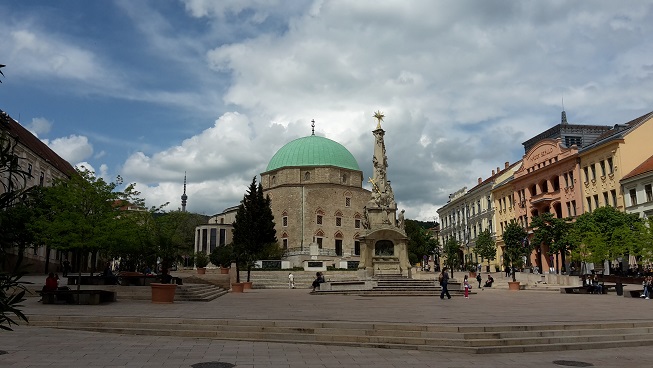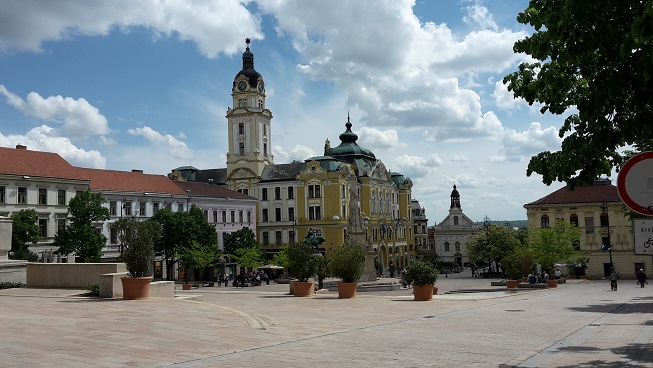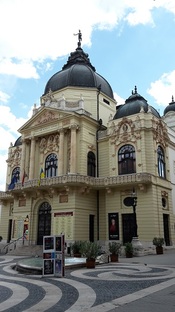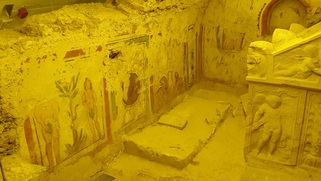28/04/2015 As I went over to Central European time yesterday, and my clock went back an hour from the Eastern European time that Greece, Bulgaria and Romania operate on, I managed to get off to an early start today.
My route first took me through the Serbian city of Subotica (I was camped only 5km outside it).Lonely Planet rates it as a city of a certain interest with some Art Nouveau buildings.It was an Austro-Hungarian city until 1920. I didn’t spot anything worth stopping for and headed straight through, crossing back into Hungary at the quiet crossing of Kelebija.To get to Pecs,I headed west parallel to the border for 60km.I had seen that Hungary has a very modern motorway network(if you want to go to or from Budapest-as all motorways radiate from it).I wondered what it might be like on the lesser roads circling the country.For this first 60km I travelled on a road that was being totally refurbished, some stretches with the tarmac so new it hadn’t dried, others where the old road had been scalped but not re-laid, and there were a number of traffic lights which delayed me a bit, and a massive army of workforce,but eventually I reached the M6 motorway and roared towards Pecs.The Hungarian road signs work on the British system, motorways designated “M” and signed in blue, and lesser roads signed in green. This is exactly the reverse of every other country I’ve been in, where the convention is for green signs indicating motorways, usually designated “A”, and blue signs for lesser roads.
As well as the changes in road signs,I have had to contend with the different currencies,each new one seeming to move the decimal point one place.There are 6.27 Romanian Lei to the pound,170 Serbian Dinars to the pound, and 420 Hungarian forints (nicely known as the HUF)to the pound. I’ve had all three in my wallet in the last couple of days and confused some shopkeepers (and myself)by handing them the wrong currency, more than once, and the mental maths to calculate equivalent values is a bit taxing.
Before reaching the motorway the land was totally flat, the Hungarian plain, which I have been travelling through since 50km before the Hungarian/Romanian border. On crossing the Danube this morning ,travelling East to West ,the land started to get a little hilly,and wooded.This is known as South Trans-Danubia and is recognised as an area of outstanding natural beauty.I skirted the town of Mohacs,famous for its two battles.In 1526 there was a decisive Ottoman victory here which secured a large area of Hungary for the Ottoman empire.In 1687 there was another battle here at which this time the Ottomans were decisively defeated and it marked the start of the decline in Ottoman fortunes in Europe.
In Pecs I first looked in on a potential campsite, supposedly open all year according to its website and several guides,but the person I had earlier reached on the phone to check couldn’t speak English.Following earlier experiences I was not unsurprised to find it shut until May but I had a plan B which was to head out of town 15km to another one, definitely open, once I had seen the town.
Pecs is a pleasant city.It has a reputation as a cultural centre and has a huge attractive central square, pedestrianised streets, vestiges of some medieval walls, many grand Austro-Hungarian buildings, and at least one (non-functioning) mosque, left over from the Ottoman occupation. It is a modern city too, with food in the restaurants very much international. I did have to circuit the town centre 3 times before I spotted a suitable parking place but after that it was just 500 yards walk to the sights.
My route first took me through the Serbian city of Subotica (I was camped only 5km outside it).Lonely Planet rates it as a city of a certain interest with some Art Nouveau buildings.It was an Austro-Hungarian city until 1920. I didn’t spot anything worth stopping for and headed straight through, crossing back into Hungary at the quiet crossing of Kelebija.To get to Pecs,I headed west parallel to the border for 60km.I had seen that Hungary has a very modern motorway network(if you want to go to or from Budapest-as all motorways radiate from it).I wondered what it might be like on the lesser roads circling the country.For this first 60km I travelled on a road that was being totally refurbished, some stretches with the tarmac so new it hadn’t dried, others where the old road had been scalped but not re-laid, and there were a number of traffic lights which delayed me a bit, and a massive army of workforce,but eventually I reached the M6 motorway and roared towards Pecs.The Hungarian road signs work on the British system, motorways designated “M” and signed in blue, and lesser roads signed in green. This is exactly the reverse of every other country I’ve been in, where the convention is for green signs indicating motorways, usually designated “A”, and blue signs for lesser roads.
As well as the changes in road signs,I have had to contend with the different currencies,each new one seeming to move the decimal point one place.There are 6.27 Romanian Lei to the pound,170 Serbian Dinars to the pound, and 420 Hungarian forints (nicely known as the HUF)to the pound. I’ve had all three in my wallet in the last couple of days and confused some shopkeepers (and myself)by handing them the wrong currency, more than once, and the mental maths to calculate equivalent values is a bit taxing.
Before reaching the motorway the land was totally flat, the Hungarian plain, which I have been travelling through since 50km before the Hungarian/Romanian border. On crossing the Danube this morning ,travelling East to West ,the land started to get a little hilly,and wooded.This is known as South Trans-Danubia and is recognised as an area of outstanding natural beauty.I skirted the town of Mohacs,famous for its two battles.In 1526 there was a decisive Ottoman victory here which secured a large area of Hungary for the Ottoman empire.In 1687 there was another battle here at which this time the Ottomans were decisively defeated and it marked the start of the decline in Ottoman fortunes in Europe.
In Pecs I first looked in on a potential campsite, supposedly open all year according to its website and several guides,but the person I had earlier reached on the phone to check couldn’t speak English.Following earlier experiences I was not unsurprised to find it shut until May but I had a plan B which was to head out of town 15km to another one, definitely open, once I had seen the town.
Pecs is a pleasant city.It has a reputation as a cultural centre and has a huge attractive central square, pedestrianised streets, vestiges of some medieval walls, many grand Austro-Hungarian buildings, and at least one (non-functioning) mosque, left over from the Ottoman occupation. It is a modern city too, with food in the restaurants very much international. I did have to circuit the town centre 3 times before I spotted a suitable parking place but after that it was just 500 yards walk to the sights.
I was particularly keen to see the local Unesco World Heritage site of 4th century Early Christian Roman tombs, apparently rather unusual because they are a series of little mausoleum–type tombs with buildings enclosing them.
These are right in the city centre, in a museum created in the modern cellars of the buildings they are under, and is quite a maze through passages to get to them all, which are all jumbled up with foundations of medieval town wall etc. The wall paintings are fairly similar to those in some chambers of the catacombs in Rome,and have Christian images such as Saints, and Adam and Eve.Defininitely worth seeing.
These are right in the city centre, in a museum created in the modern cellars of the buildings they are under, and is quite a maze through passages to get to them all, which are all jumbled up with foundations of medieval town wall etc. The wall paintings are fairly similar to those in some chambers of the catacombs in Rome,and have Christian images such as Saints, and Adam and Eve.Defininitely worth seeing.
At 4pm I took the road north out of town to the little spa village of Sikonda in the wooded hills above Pecs where there is a good campsite .Fortunately I’m heading on in the same direction tomorrow. What was nice was that for the equivalent of £5 I was able to treat myself to the spa in the smart hotel across the road. There was a very stylish modern spa with 3 pools, jacuzzis, two types of sauna (Finnish and herbal),a steam room, and even a salt cave, the whole place with about 5 people in it. I think I came out the cleanest I’ve been for a couple of months! Having seen the price of the hotel restaurant (£10 for a four course all-you-can-eat buffet, £1 for a glass of wine) I headed back later that evening for a blow-out.
At dinner I was glad to see that one of the puddings was the Hungarian version of an Austrian ski-trip favourite, Kaiserschmarren. The Hungarian is ‘Csaszarmorza’ which unusually for Hungarian bears a resemblance to the German word, but Hungarian is like no other European language other than Finnish and is a bit of a challenge. Normally you can get the gist of important words in the Latin or Germanic languages. For example, ‘Police ‘is usually something like ‘Policia,Politie.Politzei’ etc and is recognisable. Here the word for police is ‘Rendorseg’ :yes,I have already been stopped by the Rendorseg ! At a routine roadside check just over the border where I think they were targeting the driving licences of foreign cars.
At dinner I was glad to see that one of the puddings was the Hungarian version of an Austrian ski-trip favourite, Kaiserschmarren. The Hungarian is ‘Csaszarmorza’ which unusually for Hungarian bears a resemblance to the German word, but Hungarian is like no other European language other than Finnish and is a bit of a challenge. Normally you can get the gist of important words in the Latin or Germanic languages. For example, ‘Police ‘is usually something like ‘Policia,Politie.Politzei’ etc and is recognisable. Here the word for police is ‘Rendorseg’ :yes,I have already been stopped by the Rendorseg ! At a routine roadside check just over the border where I think they were targeting the driving licences of foreign cars.






 RSS Feed
RSS Feed